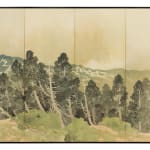Nishii Keigaku 西井敬岳
Mountain Landscape, ca 1916-1920
Pair of six-panel folding screens; ink and mineral colors on silk
Size each screen 66 x 147 in. (167.5 x 373 cm)
T-4626
Further images
-
(View a larger image of thumbnail 1
)

-
(View a larger image of thumbnail 2
)

-
(View a larger image of thumbnail 3
)

-
(View a larger image of thumbnail 4
)

-
(View a larger image of thumbnail 5
)

-
(View a larger image of thumbnail 6
)

-
(View a larger image of thumbnail 7
)

-
(View a larger image of thumbnail 8
)

-
(View a larger image of thumbnail 9
)

-
(View a larger image of thumbnail 10
)

-
(View a larger image of thumbnail 11
)

-
(View a larger image of thumbnail 12
)

-
(View a larger image of thumbnail 13
)

-
(View a larger image of thumbnail 14
)

-
(View a larger image of thumbnail 15
)

-
(View a larger image of thumbnail 16
)

-
(View a larger image of thumbnail 17
)

-
(View a larger image of thumbnail 18
)

-
(View a larger image of thumbnail 19
)

-
(View a larger image of thumbnail 20
)

-
(View a larger image of thumbnail 21
)

-
(View a larger image of thumbnail 22
)

-
(View a larger image of thumbnail 23
)

-
(View a larger image of thumbnail 24
)

-
(View a larger image of thumbnail 25
)

-
(View a larger image of thumbnail 26
)

-
(View a larger image of thumbnail 27
)

-
(View a larger image of thumbnail 28
)

-
(View a larger image of thumbnail 29
)

-
(View a larger image of thumbnail 30
)

-
(View a larger image of thumbnail 31
)

Nishii Keigaku, a prolific and successful artist, was born in Fukui Prefecture, the son of Nishii Keibi, an official painter to the Matsudaira clan, lords of the local feudal fiefdom....
Nishii Keigaku, a prolific and successful artist, was born in Fukui Prefecture, the son of Nishii Keibi, an official painter to the Matsudaira clan, lords of the local feudal fiefdom. In 1902 Keigaku went to Kyoto to study with Yamamoto Shunkyo (1871–1933), a leading landscape painter: Yamamoto’s career largely overlapped with Nishii’s and he painted many screens that clearly influenced the latter, only nine years his junior. Nishii quickly began to win prizes with several art associations and showed regularly at the national Bunten salon from 1907 to 1918. In 1919 he joined other painters in forming the Nihon Jiyū Gadan (Japan Free Painting Group) and presented his work regularly at the group’s shows; he also traveled and painted extensively in China and Korea.
Starting during the mid 1910s, Nishii’s large-format works tend to depict actual, rather than imaginary locations, typically in the regions of Japan or sometimes in Korea. This majestic pair of landscape screen shares close similarities to another pair of screens with a mountainscape entitled Unzan kōitsu (“Cloudy Mountains, Lofty Eminences” or “Untrammeled Scholar Among Cloud-Filled Mountains”), that Nishii exhibited at the 1916 Bunten national art salon.
Starting during the mid 1910s, Nishii’s large-format works tend to depict actual, rather than imaginary locations, typically in the regions of Japan or sometimes in Korea. This majestic pair of landscape screen shares close similarities to another pair of screens with a mountainscape entitled Unzan kōitsu (“Cloudy Mountains, Lofty Eminences” or “Untrammeled Scholar Among Cloud-Filled Mountains”), that Nishii exhibited at the 1916 Bunten national art salon.






























